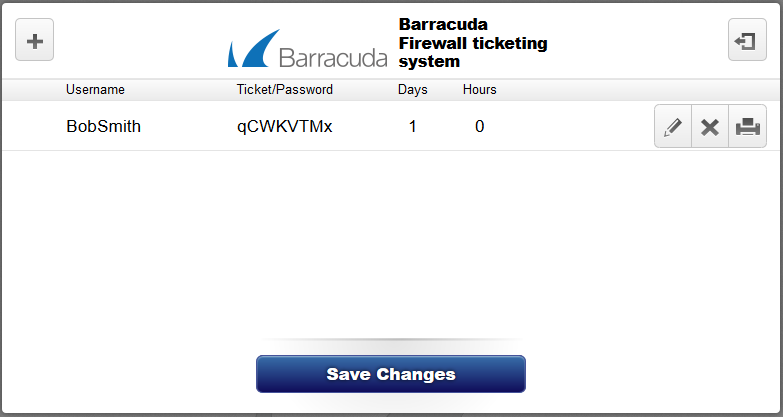You can configure a fully customizable web-based portal that displays a disclaimer and requests login credentials from users when they first try to access the Internet or special network segments. For example, you can configure a Guest Access that looks similar to the following page:
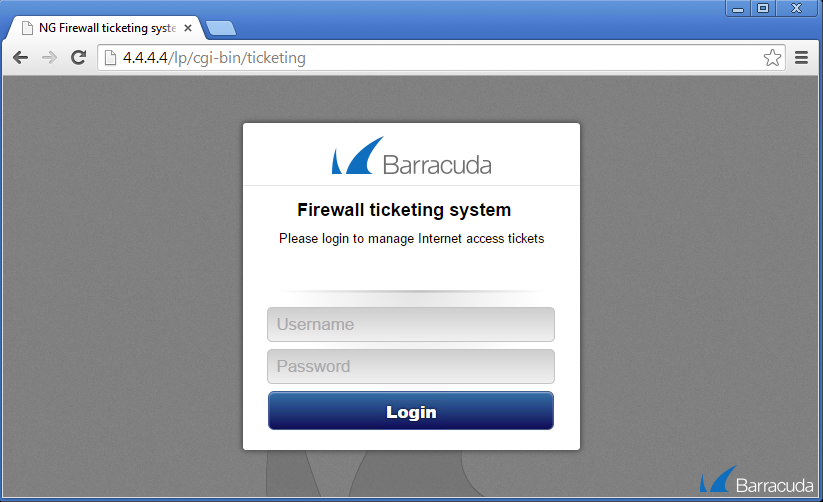
To administer tickets for the Guest Access, you can also enable a web-based backend user interface for creating, deleting, managing, or printing tickets.
Step 1. Enable Guest Access
- Go to CONFIGURATION > Configuration Tr ee > Box > Assigned Services > Wi-Fi > Wi-Fi AP Configuration .
- Click Lock.
- From the Guest Access list, select either Confirmation or Ticketing. If you want to disable the Guest Access, select None.
- Click Send Changes and Activate.
Step 2. Configure Guest Access
- Go to CONFIGURATION > Configuration Tr ee > Box > Assigned Services > Firewall > Forwarding Settings .
- In the left menu, select Guest Access.
Click Lock.
You can specify the following settings for the Guest Access:
Section Setting Description Timing Renew Confirmation After (min.) The time period after which users must re-enter their login credentials.
Auto. Renew Confirmation Confirmation is automatically renewed within this time period, after the last confirmation has timed out. The user does not need to re-enter login credentials. Customization (Confirmation) Custom Text Custom text that is displayed on the confirmation window. If left blank, the default Barracuda Networks disclaimer is displayed.
Header Logo (Only visible in advanced view) The customizable header image for confirmation Guest Access.
Add the fully qualified path, including the file name with the file name extension as the reference for the header logo. For example:
/lp/lib/myCustomLogoHeader.pngThe maximum size for the image is 250 x 60 pixels.
Custom Page (Only visible in advanced view) A custom index.html file for the Guest Access. See the description below this table to learn how to configure the custom HTML code.
Before specifying an index.html page in this field, you must upload it. From the Configuration menu in the left navigation pane, click Authentication Messages. Add the file to the Custom HTML Files table.Customization (Ticketing) Custom Text Custom text that is displayed on the confirmation window. If left blank, the default Barracuda Networks disclaimer is displayed. Header Logo (Only visible in advanced view) The customizable header image for ticketing Guest Access. From the Configuration menu in the left navigation pane, click Authentication Messages. Add the picture to the Custom HTML Files table within the lPsubdirectory.Custom Page (Only visible in advanced view) A custom index.html file for the Guest Access. See the description below this table to learn how to configure the custom HTML code.
Before specifying an index.html page in this field, you must upload it. From the Configuration menu in the left navigation pane, click Authentication Messages. Add the file to the Custom HTML Files table.Ticketing Administration User
Username The username for the administrator of the ticketing list backend page.
Password The password for the administrator of the ticketing list backend page. Additional Guest Access Networks Network Defines additional network segments (except the Wi-Fi network where Guest Access are served to clients). You can select a network object or manually enter a network segment.
Type
The type of Guest Access for the additional network segments. You can select Confirmation or Ticketing.
The customizable index.html page mentioned above is also the HTML template for the Next Token, New Pin, Accept New Pin and One-time Password Authentication pages. You can use special tags in HTML comments within the index.html to enter content to be displayed only on the respective pages. The following tags are available:
- Next token:
%%NEXTTOKENMSG-BEGIN%% %%NEXTTOKENMSG-END%% - New pin:
%%NEWPIN-BEGIN%% %%NEWPIN-END%% - Accept new server-generated PIN:
%%ACCEPTNEWPIN-BEGIN%% %%ACCEPTNEWPIN-END%% One-time password authentication:
%%OTP-BEGIN%% %%OTP-END%%
Start your conditional HTML code block with a comment tag (<!–) directly followed by the respective special opening tag, and end it with a closing comment tag (-->) directly preceded by the respective special ending tag.
(optional) Step 3. Upload Custom Header Logo for Guest Access
In case you want to display custom header logos for Guest Access, you must upload the image file. Note that in order for the web server to access the file, it is necessary to set the path to /lp/lib.
- In the left menu, click Authentication Messages
- Click + to add a custom image header file.
- In the window, enter the full file name including the file extension, i.e.,
myCustomLogoHeader.png
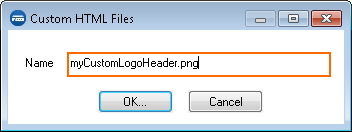
- From Type, select Binary.
- Enter
/lp/libfor the Path. - Click Ex/Import to select the source where to upload the header logo image from.
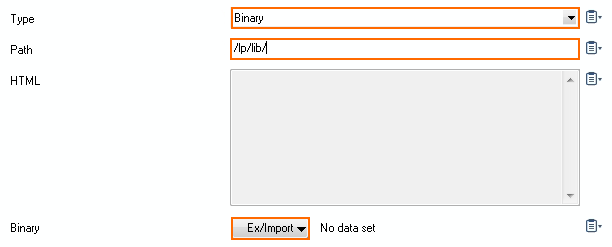
- Click OK.
- Click Send Changes.
- Click Activate.
View Authenticated Users
To see a list of authenticated users, go to the FIREWALL > Users page. On this page, successfully authenticated users are listed with either the LP- or TKT- prefix, followed by the IP address of the client.
Authenticated Users in Access Rules
Using the IP addresses on the FIREWALL > Users page, you can create access rules to regulate network access for authenticated users. In the rule editor window, specify the authenticated users in the Authenticated User field.
For example, a user is successfully authenticated from the Guest Access on a client with the IP address of 172.16.10.100. On the FIREWALL > Users page, the authenticated user is displayed with the following identity: LP-172.16.10.100. In the following access rule example, this identity string is used to allow Internet access for users that are authenticated on the Guest Access in the 172.16.10.0/24 network:
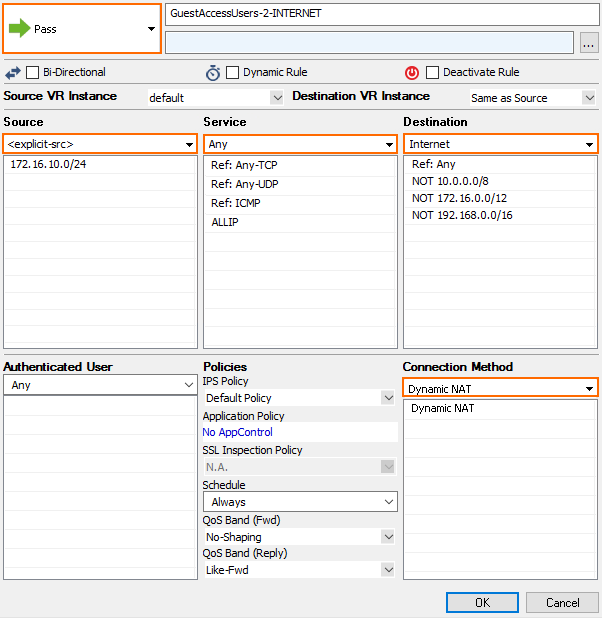
The user=LP-172.16.10 string indicates that this access rule only applies to users who are residing in the 172.16.10.0/24 network and are currently authenticated through the Guest Access.
Guest Access Ticketing System
To administer tickets for the Guest Access, the Barracuda CloudGen Firewall offers a web-based backend user interface for creating, deleting, managing, or printing tickets.
Access to the Admin Ticket Interface
HTTP requests (port 80/443) that are addressed to the system that is running the Guest Access must be forwarded to the local web server of the system. Create a access rule that forwards these HTTP requests to the local web server.
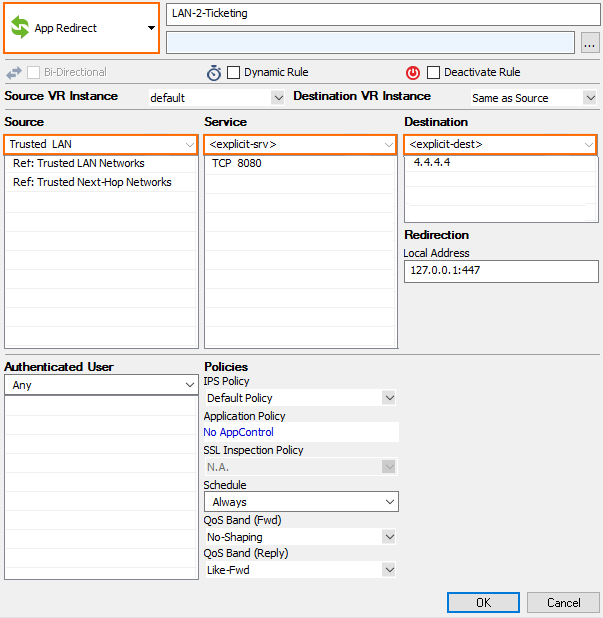
Ticketing Next Steps
After you create an access rule that grants access to the ticket system, you can connect to the ticketing interface from a web browser.
- In a web browser, enter:
http://<IP:port>/lp/cgi-bin/ticketing - On the ticketing system login page, enter the login credentials that you specified in the Ticketing Administration User section when configuring the Guest Access.
For more information, see How to Manage Guest Tickets - User's Guide .

